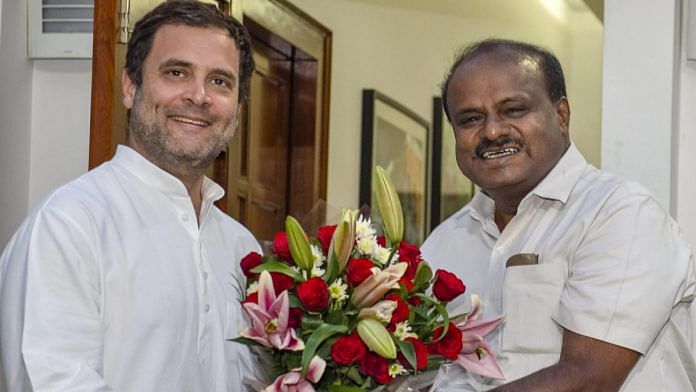The gen-next leaders are more pragmatic, willing to take risks, and even forego their egos for political survival.
It was former Prime Minister Atal Bihari Vajpayee, who said that a politician in India is born at the age of 50, becomes a teenager at 60, and a youth icon at 70.
Indian politics, however, is currently witnessing a generational change in political dynasties, including the Congress, wherein older, established leaders are giving way to their children, who are mostly under 50.
It is these gen-next leaders, who may play a role in the 2019 Lok Sabha polls, individually and collectively. Interestingly, the country also has a young population, with 65 per cent under 35.
Rahul Gandhi has officially taken over the reins of the Congress party in December last year. Former Uttar Pradesh chief Minister Akilesh Yadav has replaced his father Mulayam Singh as the Samajwadi Party chief. Ajit Singh of the RLD has yielded place to his son Jayant Chaudhary. M.K. Stalin became the DMK working president in January 2017. Andhra Pradesh chief minister Chandrababu Naidu’s son Lokesh is seen as his successor already, and so is the TRS chief K. Chandrasekhar Rao’s son K.T. Rama Rao. Similarly, Mehbooba Mufti succeeded her father as the chief minister of Jammu and Kashmir.
Will the gen-next leaders challenge Modi, who continues to be popular despite his inability to fulfil his 2014 electoral promises?
Leading a united opposition
The opposition is emboldened to take on Modi after the recent Karnataka assembly results, and the bypoll wins in UP, Bihar and elsewhere. The swearing-in ceremony of Karnataka chief minister H.D. Kumaraswamy saw Congress leaders Sonia Gandhi and Rahul sharing the stage with Akhilesh Yadav, Tejashwi Yadav, Ajit Singh, Mamata Banerjee, Mayawati, Chandrababu Naidu, and Sitaram Yechury, among others.
It was a show of strength and a warning to the BJP. The question is: can they succeed? The opposition strategy to form a grand alliance against a formidable ruling party is not new. It has been tried out in 1971, 1977, 1989, and 2004. Except 1971, the opposition unity has paid dividends on other occasions.
What, perhaps, works in favour of these gen-next leaders is that most of them have no political baggage except their dynastic lineage. They are more pragmatic, willing to take risks, and even forego their egos for political survival. Akhilesh and Jayant are foreign-educated and modern in their approach. Akhilesh even appointed an American adviser for his campaign strategy before the assembly election.
These gen-next leaders have a new style of campaigning, and actively use the social media. Above all, they have realised that their common enemy is the BJP. It is the Hindi heartland, where the BJP is strong, that they need to focus on. Uttar Pradesh and Bihar together send 120 members to the Lok Sabha. The coming together of the SP, the BSP, the RLD and the Congress has proved to be a successful formula in Uttar Pradesh.
Showing greater flexibility
In Bihar, RJD chief Lalu Prasad Yadav’s son Tejashwi has established himself by winning the bypoll against the combined might of the JD(U) and the BJP. He is a school dropout, but has learnt the street-smart politics from his father. Like Lalu, he also supports the Congress.
As for Stalin, he is hard-working but not a charismatic leader like his father. He has, however, learnt the tricks of the trade from his father, and is also flexible. Stalin has to keep his Dravidian votes intact, and find a viable coalition to win the state, which has 39 Lok Sabha seats. He must also try to occupy the space left after the death of Jayalalithaa in December 2016. The DMK is currently a Congress ally, and Stalin is keen on opposition unity.
The younger leaders are willing to befriend others for their own politics. For instance, Jayant Chaudhary, the third-generation Jat leader, claims that a simple text message to Akhilesh Yadav before the Kairana bypoll brought the two parties together, setting the tone for the 2019 polls.
Akhilesh is already on nephew-aunt terms with Mayawati. It was a phone call from Priyanka Gandhi to Akhilesh’s wife Dimple that settled the ticket-sharing with the Congress before the Uttar Pradesh polls. By accepting Kumaraswamy in Karnataka, Rahul has shown his new political shrewdness.
Challenges ahead
But minus points (against these gen-next leaders) are more formidable. Defeating Modi and fighting the BJP’s election machinery, muscle and money power may not be that easy. While the opposition leaders at the top may kiss and hug, what happens to the workers at the ground level, who had fought each other?
Second, just negative views against Modi cannot sustain the new coalition without a new narrative. Third, the regional leaders have no pan-national appeal. Although they represent the youth, they are basically sectarian leaders. Their success represents an aggregate of various blocks. We don’t know which factor will play nationally.
In short, the gen-next leaders should woo the anti-Modi voters to increase their seat count. The proof of the pudding is in the additional votes they will bring to the table. It will be arithmetic as well chemistry, which will work for the opposition success. Will they be able to achieve this?







This is paid news, hilarious !
What kind of journalism is theprint pursuing when they constant target just one ideology.
This is a superficial article that eats up THE PRINT’S server space. In a democracy, there is always someone to challenge the incumbent. The author belongs to the category of journalists who would mock Smriti Irani’s educational qualification, but go an extra mile to justify the political acumen of a rookie school-dropout like Tejashwi Yadav.